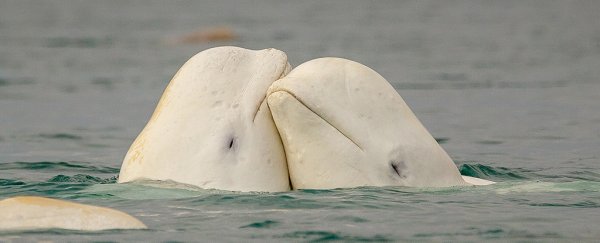Similar to orcas and pilot whales, the enigmatic beluga whale has long been assumed to live out their lives in pods based around close maternal ties. But new research shows their social structures go far beyond sibling quid-pro-quo.
By combining DNA profiling with mathematical network analysis, researchers have found belugas (Delphinapterus leucas) across the Arctic hang out in far more diverse crowds than their other whale species.
Research led by Florida Atlantic University's Harbor Branch Oceanographic Institute confirms suspicions that belugas regularly interact with their mother's side of the family, not unlike other closely related species of toothed cetacean.
Matriarchal lineages are common among families of sperm whale, orca, and pilot whale, which routinely have a female whale leading the way. Analysis of the beluga groupings, both large and small, found they often had more than one matriline.
What they didn't expect were the frequent associations with dad's side of the clan. Or the close relationships with cousins. Or, more surprisingly still, the hints of networks involving individuals without any close genetic relationship.
"Unlike killer and pilot whales, and like some human societies, beluga whales don't solely or even primarily interact and associate with close kin," says lead researcher and marine biologist, Greg O'Corry‑Crowe.
"Across a wide variety of habitats and among both migratory and resident populations, they form communities of individuals of all ages and both sexes that regularly number in the hundreds and possibly the thousands."
These beluga neighbourhoods are far more like our own complex webs involving grandparents, uncles, second cousins, and possibly even non-familial friends, than most other social species.
What's more, they were also dynamic, showing shifting patterns of interaction that varied from short-lived associations to multi-year affiliations we might imagine to be long-term friendships.
"This variation suggests a fission-fusion society where group composition and size are context-specific, but it may also reflect a more rigid multi-level society comprised of stable social units that regularly coalesce and separate," says O'Corry‑Crowe.
Just what role kinship plays in this complex array of relationships is hard to predict. But it could tell us a thing or two about how it all evolved in the first place.
From a strictly evolutionary viewpoint, it makes sense to take a few risks and make some sacrifices for your brothers and sisters.
After all, chances are they share a good chunk of your genetic material, and are probably young enough to see it be passed on to another generation.
But as the family tree branches further out, the chances that a relative will share the genes that make you unique diminish, making it more likely your act of kindness isn't going to give your DNA blueprint any real advantage.
This principle of kin-selection, where the genes behind altruistic behaviours were given a boost by closely-related families working together, is of course just one of many pressures guiding the evolution of social structures.
Learned behaviours, or what we might call culture, can also exert an influence on how animals associate.
Perhaps the most gratuitous example is having a wise maternal figure sticking around to pass on her knowledge long after her reproductive contributions have ended.
In 2018, belugas were added to the rather exclusive 'Grandmothers Club', consisting of social animals that enjoy the benefits of post-menopausal relatives.
By studying more complex associations among animals other than humans, we can gain a better idea of the significance these diverse evolutionary pressures in the evolution of social behaviour.
"This research will improve our understanding of why some species are social, how individuals learn from group members and how animal cultures emerge," says O'Corry‑Crowe.
"It also has implications for traditional explanations based on matrilineal care for a very rare life-history trait in nature, menopause, which has only been documented in a handful of mammals, including beluga whales and humans."
With global warming driving rapid climate change in the Arctic's waters, it's shocking that we still know so little about these magnificent aquatic mammals.
Knowing now just how rich their relationships are just might give us a few clues on how to do our best to help their communities survive those changes to come.
This research was published in Scientific Reports.
